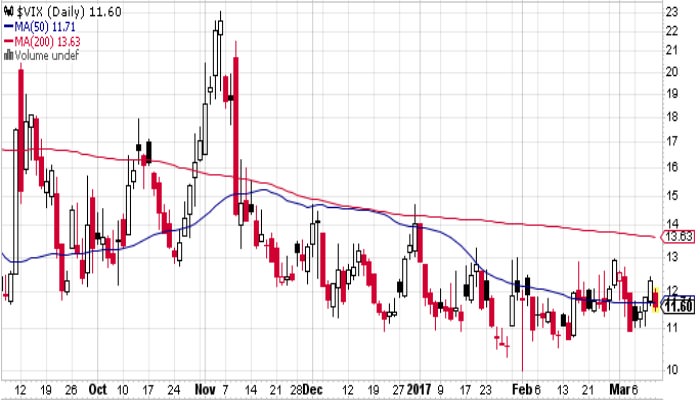Will Volatility Be Bad Or Good For The Market?
With the current volatility, anyone can see that the market is headed in one direction and it has been pretty single minded in nature. However, you need to know whether or not the complacency actually means anything. Look at where the market is while looking from a historical point of view. For example, you have the VIX Index, which is where you measure the volatility of the market and it is sitting at around 11.60 as of March 10, 2017.
What is Volatility Index?
Volatility Index of the Chicago Board Options Exchange was developed by Robert E Whaley from Duke University in 1993. Its ticker symbol is VIX in the NY Stock Exchange, and this is how everyone refers to it.
The values were back calculated by the CBOE to January 1986, and it was initially tied to the options of the S&P 100 Index or OEX. However, it changes to the volatility of the S&P 500 Index, or SPX options, in 2004.
The exchange will take a simple basket of options and then calculate the average as though there were 30 calendar days there were left until expiration.
There are other indexes that are related, such as the VXO index, which is also known as the old VIX due to it being calculated in the same way that it used to be, using the S&P 100 Index. There is also the VXN, which deals with volatility measurement that is based upon the options of the NASDAQ 100 Index. This is similar to QQV based upon the options of the Tracking Stock, or QQQ, of the NASDAQ 100 Index.
Volatility vs. complacency
Volatility is basically the opposite of, meaning that whenever the market is volatile, the investors will buy options market downside protection. This will, in turn, drive the value higher for the VIX. It is easy to tell that this is not the first time that the VIX has been quite as low. However, the chart above confirms low volatility stays pretty low on a historical basis. When the volatility ends up being an opposite of complacency, how will you measure the complacency? Will the market be complacent if the measures of volatility are really low? Will this matter?
A better question to ask may be whether or not the complacency can cause the market volatility? It can, and when the markets are complacent, they can be shocked easily. With the redirection of the market, it will depend on whatever is causing the volatility.
The volatility will usually be associated with the decline of the market. Whenever an investor hears about volatility, they will think about the market moving lower. The complacency will lead investors to think about the static and dull markets. If the investors are not going to be buying protection, it will usually be because they will see that there is more risk with the upside rather than the downside.
While looking carefully at the market, it has been more volatile. As a matter of fact, the volatility has brought about a melt up to about 12% since around November 9th, 2016 with the S&P 500. You may remember the shock that took place on that actual day.
In conclusion
You have to keep in mind that volatility may mean that the price will rise just as much as it drops, from a mathematical standpoint. With a bull market, the call options sellers should be demanding higher premiums and driving up the implied volatility. In theory, the higher VIX can also mean that there is a bull market, especially one that is extreme.
GOT SOMETHING TO SAY:
Related articles
Trading signal service for you!
News Blog
